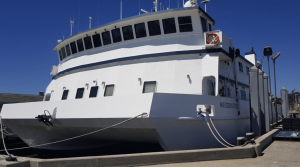Alexander Hoover, an assistant professor in the Department of Mathematics and Statistics at Cleveland State University, has always been fascinated by marine organisms—the way they move, survive and interact with their habitats. Over the past decade, his research has focused on the interplay of fluids, mechanics and behavior that helps organisms engage in flying, swimming and other activities, an area of study called computational fluid-structure interactions.
The Ohio Supercomputer Center (OSC) has played a crucial role in Hoover’s research, enabling him to run complex 3D simulations that would otherwise take days or even weeks to complete.
“OSC allows me to collaborate effectively with marine biologists, engineers and oceanographers, exploring various questions and determining if my model can provide answers,” Hoover said. “These models enable us to perform experiments that wouldn’t be possible otherwise.”
In 2021, Hoover published a paper on jellyfish neuromechanics and how these organisms function without a centralized nervous system or “brain.”
Jellyfish, despite having a simple nervous system, can move in various ways thanks to a network of pacemakers that trigger waves of muscle contractions. Hoover’s study showed that the success of jellyfish turning one way or the other depends on the speed of these activation waves. By using a 3D computational model, Hoover found that when the wave speed is close to the material wave speed of the bell, which is the jellyfish’s umbrella-shaped body, it results in the strongest turns and greatest flexibility.

Hoover’s findings will provide insights for developing soft robotic devices and tissue-engineered pumps, aiding future biomedical applications. In his research, Hoover continues to learn more about biomechanics and fluid dynamics and to form design principles that could then be translated to other bio-inspired applications.
Hoover now is examining how pacemakers contribute to a jellyfish’s stability and movement in water columns, and also is researching the mathematics of jellyfish swarming, which could provide new information about jellyfish blooms observed in the ocean.
Hoover has utilized OSC’s resources while collaborating in the field with researchers from the Monterey Bay Aquarium Research Institute in California. These expeditions take Hoover and his collaborators 900 meters (about 2,952.76 feet) deep into the ocean to capture video and sometimes collect organisms for further study.

“When we’re off the ship, I create mathematical models which I then run on the supercomputing clusters at OSC,” Hoover said. “The support staff at OSC has been really helpful throughout this entire process.”
Looking ahead, Hoover aims to incorporate use of OSC resources into the computational science program at Cleveland State University. Last fall, he led a class focused on computational biofluids in which students examined models Hoover created using OSC software while simultaneously running their own models on the supercomputers. This was the first class to offer graduate students direct experience in research computing on OSC clusters, and Hoover hopes to expand these opportunities for undergraduate students.
Written by Lexi Biasi
Hoover presented his research at OSC’s April 2024 Research Symposium, which is held annually each spring to create engagement within the high performance computing community.
The Ohio Supercomputer Center (OSC) addresses the rising computational demands of academic and industrial research communities by providing a robust shared infrastructure and proven expertise in advanced modeling, simulation and analysis. OSC empowers scientists with the services essential to making extraordinary discoveries and innovations, partners with businesses and industry to leverage computational science as a competitive force in the global knowledge economy and leads efforts to equip the workforce with the key technology skills required for 21st century jobs.